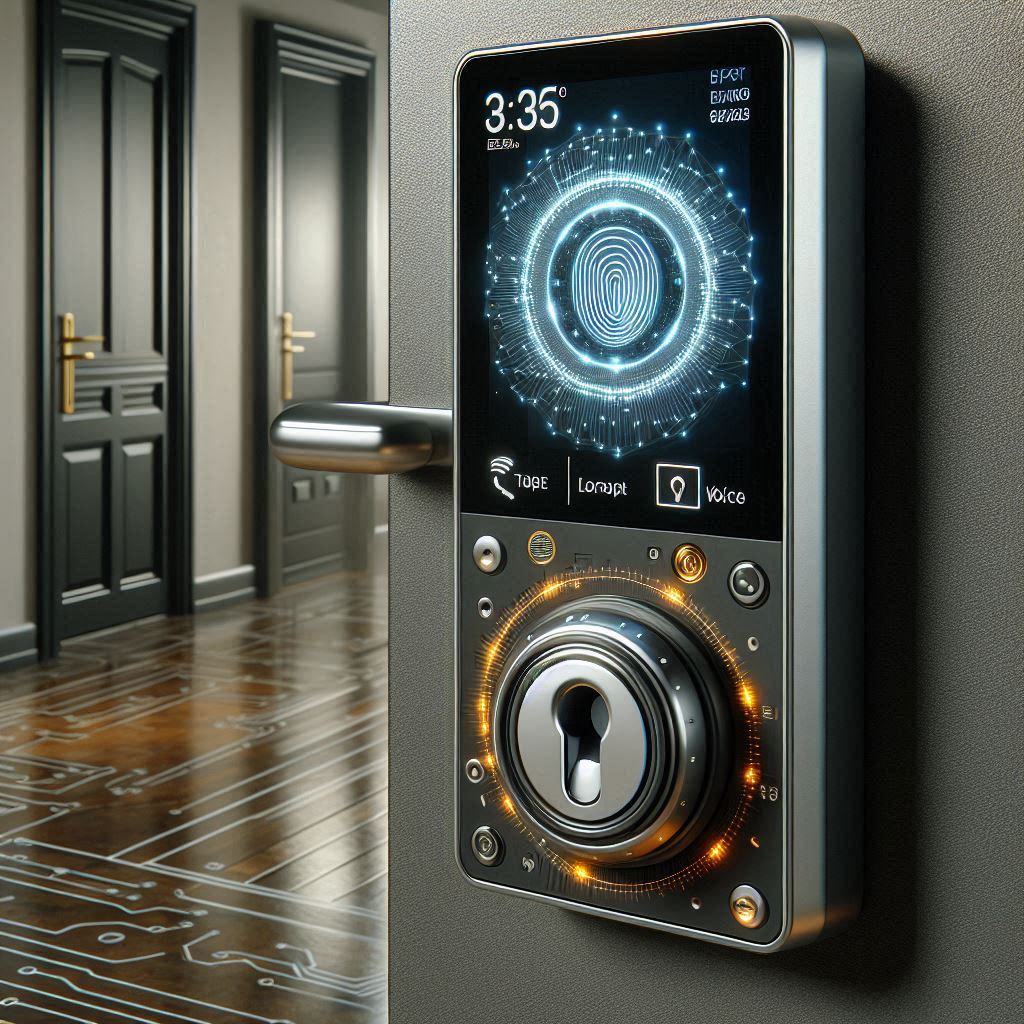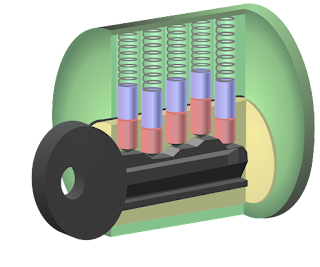Introduction- The Invention of Mechanical Lock
Since the dawn of civilization, safeguarding our valuables has been a constant human endeavor. From the hidden chambers of Egyptian pyramids to the fortified walls of medieval castles, the desire for security has fueled innovation throughout history. The invention of mechanical locks has played a significant role in safeguarding our belongings throughout history.
But the journey from simple knots of rope, used to detect tampering, to the intricate mechanisms safeguarding our homes and businesses today, has been anything but linear. It’s a story filled with ingenious minds, groundbreaking technologies, and ever-evolving threats. It’s a narrative that reflects our evolving relationship with security, from basic protection to sophisticated encryption.
In this blog, we’ll embark on a captivating exploration of this remarkable invention. We’ll delve into the ancient origins of locks, tracing their evolution from rudimentary wooden contraptions to the marvels of metalworking that defined the medieval era. We’ll unlock the secrets behind their ingenious mechanisms, from the intricate tumblers of pin locks to the elegant precision of lever locks. And we’ll examine how these seemingly mundane objects have shaped the course of history, influencing social structures, fueling economic advancements, and even impacting warfare.

But our journey doesn’t end in the past. We’ll also explore the modern marvels of lock technology, from the unpickable wonders of high-security locks to the biometric marvels that utilize fingerprints and iris scans. We’ll discuss the ongoing battle between locksmiths and lockpickers, the constant struggle to outsmart and outmaneuver each other. And we’ll ponder the future of locks, as cutting-edge technologies like digital encryption and artificial intelligence promise to reshape the landscape of security once again.
So, join us on this fascinating voyage through time and technology. Let’s unlock the secrets of the mechanical lock, appreciate its enduring legacy, and ponder its ever-evolving role in our lives. Together, we’ll discover that the story of the lock is not just about securing our belongings, but about safeguarding our very way of life.
The History of Locks
Humans are using the concept of locking doors and valuables since ancient times, early evidence of the history of locks or locking mechanisms can be found in Egyptian tombs and Roman ruins. Simple pin tumbler locks are made from wood and consist of a wooden post that is fixed to the door and a horizontal bolt that can be slid into a wooden post. Bolts have holes and a set of pins. Large specially designed keys can be inserted into holes and lifted pins and allow the security bolts to move. These locks were crude and easily bypassed, using simple keys or pins to secure them.
The modern mechanical lock was invented during the 18th century. A British locksmith Robert Barron got the first mechanical lock patent in 1778. Barron’s locks are difficult to pick due to a double tumbler system that requires a key with two distinct parts to open it.

In the centuries since Barron’s invention, countless improvements have been made to the mechanical lock. Today, we have everything from simple padlocks to high-security locks with advanced electronic systems.
Timeline of the major milestones
4000 B.C.:
The earliest known lock discovered dates back to around 4000 B.C. in ancient Egypt. Unearthed in the Khorsabad palace ruins near Nineveh, this ingenious invention used a bolt, door fixture, and key. The key, likely made of wood, featured pins that corresponded to pins within the fixture. Inserting the key lifted these pins, allowing the bolt to move. This rudimentary mechanism, though seemingly simple, showcased a remarkable early understanding of mechanical principles and security needs.
Archaeological evidence:
- The discovered lock was crafted from hardwood, suggesting its importance and durability.
- Traces of wear and tear on the keyhole and pins indicate frequent use, highlighting the lock’s practical application.
- Similar lock designs have been found in other Egyptian sites, suggesting a widespread use of this technology.
Historical context:
- This invention coincided with the rise of powerful centralized Egyptian dynasties, who needed to secure their vast treasures and administrative centers.
- The lock’s presence in tombs reflects the Egyptians’ profound belief in the afterlife and the importance of protecting their belongings in the next life.
2000 B.C.:
Fast forward to 2000 B.C., and we find the Assyrians taking lock technology a step further. Their wooden locks introduced the concept of keyholes and pins of varying lengths. This innovation made it more challenging to pick the lock, offering enhanced security compared to the Egyptian design.
Archaeological evidence:
- Assyrian lock remains exhibit finer craftsmanship and more intricate mechanisms compared to their Egyptian counterparts.
- Discoveries of burnt locks in Assyrian cities suggest their use in fortifications and administrative buildings, highlighting their role in protecting valuable assets.
Historical context:
- The Assyrians were a powerful empire known for their military prowess and administrative efficiency. Their advanced locks reflected their need to secure their vast territories and resources.
- The development of more sophisticated locks coincided with the rise of trade and commerce, suggesting a growing need for secure storage of valuable goods.
870 A.D.: China
While the reference to Kao Gong Ji in 870 A.D. provides a valuable glimpse into China’s engagement with lock technology, it’s just the tip of the iceberg. Let’s dive deeper and explore the fascinating world of Chinese locks, uncovering their unique features, historical context, and global significance:
Beyond a Single Mention: Evidence of Innovation:
- Archaeological discoveries: Numerous lock remains dating back to the Warring States period (475-221 B.C.E.) showcase intricate wooden mechanisms with multiple levers and complex locking systems. These finds predate Kao Gong Ji’s reference by centuries, indicating a well-established lock-making tradition in China.
- Treatises and Manuals: Not just a singular reference, texts like the “Mozi” (4th century B.C.E.) and the “Zhou Li” (1st century B.C.E.) provide detailed descriptions of various lock types, materials, and even ethical considerations for locksmiths, highlighting the widespread knowledge and importance of the craft.
- Unique Designs: Unlike the pin tumbler mechanisms prevalent in the West, Chinese locks often employ sophisticated lever systems with intricate configurations. These designs offered enhanced security and presented a unique challenge to would-be lockpickers.
1778: Robert Barron and the Double Tumbler Lock:
- Inventor: Robert Barron, a British locksmith, was renowned for his innovative lock designs.
- Problem: Existing locks were often easily picked, leaving valuables vulnerable.
- Solution: The double tumbler lock, featuring two distinct tumblers within the mechanism, required precise key alignment for both to engage, significantly increasing picking difficulty.
- Historical Context: This invention coincided with a growing demand for secure storage solutions due to rising wealth and trade. It also reflects the ongoing battle between locksmiths and lockpickers, with each side constantly innovating to outwit the other.
- Impact: Barron’s lock set a new standard for security, influencing lock designs for decades to come.

1784: Joseph Bramah and the High-Security Cylinder Lock:
- Inventor: Joseph Bramah, a prolific inventor and founder of the world-renowned Bramah Locks, held over 60 patents.
- Problem: Bramah aimed to create an unpickable lock after witnessing a public challenge by a notorious lockpicker.
- Solution: The cylindrical key, with its intricate series of notches and levers interacting with rotating disks within the lock, offered unparalleled security. Bramah famously offered a £200 reward to anyone who could pick it up within 67 years – the lock remained unpicked.
- Historical Context: This invention sparked widespread interest and debate, with some even calling it “the lock of the future.” It fueled a renewed focus on lockpicking techniques, pushing the boundaries of both offensive and defensive security measures.
- Impact: Bramah’s lock set a new benchmark for security, influencing future lock designs and inspiring generations of locksmiths and inventors.
1818: Jeremiah Chubb and the Detector Lock:
- Inventor: Jeremiah Chubb, an English locksmith and founder of Chubb Locks, dedicated his career to improving security solutions.
- Problem: Locks were still susceptible to manipulation and tampering.
- Solution: The Chubb detector lock incorporated a clever mechanism that detected and thwarted picking attempts. If the wrong key or tool was inserted, the lock would jam, preventing further attempts and alerting the owner.
- Historical Context: This invention addressed a growing concern about organized crime and sophisticated burglary methods. It further emphasized the importance of proactive security measures beyond mere physical barriers.
- Impact: Chubb’s lock gained widespread adoption in banks, businesses, and government buildings, solidifying his reputation as a leading security innovator.
1848: Linus Yale Jr. and the Birth of the Modern Pin Tumbler Lock:
- Inventor’s story: Inspired by his father’s earlier tumbler lock design, Linus Yale Jr. embarked on a quest to create a smaller, more user-friendly lock. After years of experimentation, he unveiled his masterpiece in 1848: the pin tumbler lock.
- Mechanism: Unlike the bulky tumblers of previous designs, Yale’s lock featured a flat key with individual pins of varying lengths. These pins only aligned with the correct key, offering superior security and ease of use.
- Historical impact: Yale’s invention became a commercial success, replacing older designs and establishing the pin tumbler lock as the dominant mechanism for over a century. Its influence is still seen in modern locks, a testament to its enduring ingenuity.
- Material: Yale’s locks were initially crafted from brass and iron, known for their durability and resistance to wear.
1857: James Sargent and the Dawn of Combination Locks:
- Inventor’s story: Recognizing the limitations of key-based locks, Sargent, a renowned safe manufacturer, sought a more secure and versatile solution. His combination lock, patented in 1857, replaced the key with a dial and numbered combination.
- Mechanism: The dial, featuring numbered indices, concealed a series of rotating discs that had to be aligned in a specific order to unlock the mechanism. This offered greater flexibility for multiple users and reduced the risk of lost keys.
- Historical impact: Sargent’s invention revolutionized safe technology and found applications in various sectors, from financial institutions to government buildings. It paved the way for modern combination locks, still used today for safes and high-security applications.
- Material: Early combination locks were often made of brass or steel, ensuring robustness and resistance to manipulation.
1861: Alfred Charles Hobbs and the Challenge for More Security:
- Inventor’s story: A renowned locksmith and lockpicker, Hobbs aimed to expose the vulnerabilities of existing locks. In 1861, he famously picked the Chubb lock, considered one of the most secure at the time, in just 25 minutes. This event sparked a renewed focus on lock security, driving further innovation.
- Historical impact: Hobbs’ feat highlighted the need for constantly evolving security measures. His actions directly influenced the development of more complex and sophisticated lock designs.
- Material: The Chubb lock was crafted from high-quality steel, known for its strength and resistance to drilling and picking. However, Hobbs’ success demonstrated that even the most robust materials could be overcome with sufficient skill and ingenuity.
1919: Master Lock – Securing the World, One Padlock at a Time:
In 1919, Harry Soref, a visionary entrepreneur, founded the Master Lock Company. What began as a small operation in Brooklyn, New York, quickly grew into a leading manufacturer of padlocks and security devices. Soref’s innovation lay in his commitment to durability and affordability, making his locks accessible to a wider audience.
Key Features and Impact:
- Master Lock’s signature laminated shackle, built with multiple hardened steel layers, provided superior strength and resistance to cutting tools.
- The company’s focus on standardization and interchangeable parts made repairs and replacements easier, further enhancing their appeal.
- Soref’s commitment to ethical business practices and fair labor policies earned him the respect of both customers and employees, solidifying Master Lock’s reputation as a trusted brand.
Beyond Padlocks:
While padlocks were Master Lock’s initial focus, the company diversified its offerings over time. They introduced combination locks, keyless locks, and even high-security options, catering to a broader range of security needs. Today, Master Lock remains a household name, a testament to Soref’s ingenuity and the enduring demand for reliable security solutions.
1935: Yale & Towne – Electrifying Security with the First Electric Lock:
In 1935, the Yale & Towne Manufacturing Company unveiled a revolutionary invention: the first-ever electric lock. This groundbreaking innovation replaced the traditional key-operated mechanism with a motor-driven locking system. To unlock, users entered a correct numeric code or password, adding a layer of security and convenience previously unimaginable.
Innovation and Impact:
- The electric lock’s reliance on electricity offered a more secure alternative to traditional locks, as it eliminated the need for a physical key that could be lost or stolen.
- The flexibility of code-based access allowed for easy user management and granted or revoked access remotely, ideal for businesses and institutions.
- This invention marked a significant step towards electronic security, paving the way for future advancements in access control and security systems.
Beyond the First Step:
The first electric lock by Yale & Towne was just the beginning. The company continued to refine and improve its technology, introducing more complex code systems, remote access capabilities, and even integration with security networks. Today, electric locks are ubiquitous in various settings, from office buildings and hotels to data centers and high-security facilities.
1970s: The Electronic Age Dawns:
By the 1970s, electronic locks were no longer a novelty but a rapidly maturing technology. Pioneered by companies like Schlage and Securitron, these locks offered several advantages over their mechanical counterparts:
Discovery and Working Principles:
- Motor-driven locking mechanisms: Unlike mechanical locks reliant on physical manipulation, electronic locks utilized electric motors to engage or disengage the locking mechanism.
- Circuitry and coding: The heart of an electronic lock lay in its intricate circuitry and code systems. Entering the correct code triggered the motor, granting access.
- Increased convenience: No more fumbling with keys, especially for businesses with multiple users. Access could be easily granted or revoked, enhancing security and control.

Inventors and Improvements:
- Henry Schlage: A visionary in the lock industry, Schlage introduced the first commercially viable electronic lock in the 1960s, paving the way for widespread adoption.
- Theodore Securius: The founder of Securitron, Securius focused on keyless access control systems, particularly for high-security applications.
Impact and New Perspectives:
- Commercialization: Electronic locks quickly gained traction in businesses, schools, and government buildings, offering convenient and centralized access control.
- Social impact: While offering increased security, electronic locks also raised concerns about privacy and potential misuse of access control data.
- Global perspective: While the US led the early development, countries like Japan and Germany also made significant contributions to electronic lock technology.
1990s: Biometrics – The Body Becomes the Key:
In the 1990s, the world witnessed a revolutionary shift with the introduction of biometric locks. These locks replaced traditional keys and codes with unique human characteristics like fingerprints, retinas, faces, or irises.
Discovery and Working Principles:
- Biometric sensors: These sensors capture and analyze individual characteristics, creating a digital template stored in the lock’s memory.
- Matching algorithms: When presented with the same characteristic, the lock’s algorithm compared it to the stored template, granting access only if an exact match was found.
- Enhanced security: Biometrics offered a level of security unmatched by traditional methods, as it relied on unique, unreplicable identifiers.
Inventors and Improvements:
- Paul Saintilan: A pioneer in biometrics, Saintilan developed early fingerprint recognition technologies that laid the foundation for biometric locks.
- David Dorman: Dorman’s company, Identix, commercialized fingerprint scanners and played a crucial role in bringing biometric locks to the mainstream.
Impact and New Perspectives:
- High-security applications: Biometric locks became the preferred choice for high-security facilities like banks and government buildings.
- Accessibility concerns: While offering enhanced security, some raised concerns about potential discrimination and the ethical implications of relying on biometric data.
- Future potential: Biometric technology is constantly evolving, with advancements in facial recognition and iris scanners paving the way for even more secure and convenient access control solutions.
These are just a few of the many milestones in the long and fascinating history of mechanical locks, which have played a critical role in securing our homes, businesses, and possessions for thousands of years.
Applications Mechanical locks
Home security:
One of the primary applications of mechanical locks has been to secure homes and other residential properties. From simple wooden pin locks used by the ancient Egyptians to modern deadbolts and electronic locks, homeowners have relied on mechanical locks to keep their families and belongings safe.
Business security:
Mechanical locks have also been used extensively in commercial settings to protect businesses from theft and unauthorized access. From simple padlocks on warehouse gates to high-security locks on bank vaults, businesses rely on mechanical locks to keep their assets secure.
Transportation:
Mechanical locks have been used in various types of transportation since ancient times, including locks on horse-drawn carriages and early automobiles. Today, mechanical locks are used on cars, trucks, airplanes, and boats to prevent theft and protect cargo.
Safes and vaults:
Mechanical locks have been used to secure safes and vaults for centuries, and continue to be used today. These locks must be extremely secure and difficult to pick in order to protect valuable assets such as cash, jewelry, and important documents.
Government and military:
Mechanical locks have also been used in government and military applications, from locks on weapon storage facilities to secure communications systems. The need for high-security locks in these settings has driven innovation in lock design and technology.
Art and museum security:
Mechanical locks are used extensively in art museums and galleries to protect valuable artwork and artifacts. These locks must be carefully designed and installed to prevent damage to delicate objects while still providing robust security.
Personal belongings:
Mechanical locks are also used to protect personal belongings such as luggage, backpacks, and lockers. These locks are typically small and portable, making them ideal for use on the go.
How do Mechanical Locks Work?
Mechanical locks, despite their seemingly simple appearance, hold a fascinating world of intricate mechanisms within. Understanding their inner workings unveils a clever interplay of physics, design, and security principles. Let’s delve deeper than just “pins and tumblers” to unlock the secrets of these guardians of our belongings:
Pins and Tumblers in Action:
Imagine a series of tiny pillars, the tumblers, arranged within the lock’s body. Each tumbler has a specific notch or groove. When the wrong key is inserted, its teeth don’t align with these notches, leaving the tumblers at varying heights. This creates a barrier, preventing the lock’s core from turning.
Now, enter the correct key. Its precisely cut teeth perfectly match the notches on the tumblers. As you insert and turn the key, each tumbler is lifted to a specific height, aligning them into a uniform “gate” that allows the lock’s core to rotate freely. This unlocks the door with a satisfying click.
Material Matters: Strength and Durability:
Traditionally, brass, steel, and aluminum are popular choices for lock construction, offering a balance of strength, affordability, and corrosion resistance. For high-security applications, hardened steel or even titanium might be used for added resistance to drilling or tampering.
Beyond the Basics: A Journey Through Lock Diversity:
While the pin-tumbler mechanism is the most common, the world of locks boasts a rich variety:
- Lever locks: Utilize levers instead of pins, offering increased security and resistance to picking.
- Combination locks: Replace the key with a series of rotating dials that need to be set to the correct combination to unlock.
- Padlocks: Portable locks with a shackle that secures onto a hasp or loop, offering versatile security for various applications.
- Deadbolts: Offer a high level of security by engaging a sturdy bolt deep into the doorframe.
Conclusion
The mechanical may look like a simple discovery but it has created a profound impact on human life. It has provided security to our possessions, homes, belongings and businesses. From the simple knot of ropes, it continues its development through pin wooden locks, tumbler locks, Chubb detector locks, and combination locks till modern biometric lock that uses fingerprint, retinal recognition, facial recognition & iris scanning to avoid unauthorized access by increasing their security. In short, the mechanical lock is a true innovation that has stood the test of time and will continue to play an important role in our lives for many years to come.
Check out some of my other blog posts:










